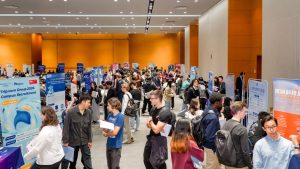26 Nov 2021
If you ever paid attention to the transport stations in China, you would be surprised by the various translations for just one term. For example, the Chinese word “广场” can be translated as “plaza”, “square”, or, in most cases, “guangchang”. In addition, different cities adopt their own translation rules, which makes them even more confusing.
This year, three students from the School of Humanities and Social Sciences analysed this phenomenon for their Summer Undergraduate Research Fellowships (SURF) project. Supervised by Dr Xiaojun Zhang from the Department of Translation and Interpreting, the SURF team offered solutions from three perspectives: policies and regulations, functions of translation, and public opinions.

What is an effective translation
“There are two major conflicts with regards to translating geographical names,” says Zhongyun Jia, a Year Four student from BA Applied English “One is the conflict between administrative regulations and the audience’s needs, the other is the inconsistent translations among different cities.”
In 1986, the government launched the Administrative Regulations for Geographical Names. The document stated that geographical names should use Pinyin, which is the standard system of romanised spelling for transliterating Chinese. In the same year, The Ministry of Civil Affairs also clarified that English translation is not allowed.

“However, local regulations are inconsistent with this policy. For example, Shanghai People’s Government launched Shanghai Geographical Name Translation Guidelines, where proper names use Pinyin and common names use English,” Jia says. “Shenzhen and Hangzhou have also launched similar regulations recently.”
“The situation pushes us to reflect what the purpose of the translation is, why rail transit station names need to be translated, and what makes an effective translation,” says Xinyi Fang, also a Year Four student from BA Applied English.
Effective translation requires coherent structure, accurate information, adherence to ethical guidelines, and meeting the needs of different target audiences. Among them, accuracy is the most important, so that people from different cultural and linguistic backgrounds can understand.
Based on the questionnaires and interviews, the students found that both domestic and international audiences agree that functional terms should use English, such as the names of roads, streets, paths, stations, and directions, while geographical names that have historical and cultural connotations can be translated into Pinyin.
“One surprising finding is that most interviewees prefer Pinyin for culturally significant geographical names, such as Yuanmingyuan,” says Yingzi Guo, a Year Three student from BA English and Communication Studies. Yuanmingyuan, also known as the Old Summer Palace, was destroyed during the Second Opium War.
“One of the interviewees suggested that it’s good to leave some room for interpretation and discovery instead of giving all the information,” says Guo.
An one-in-all solution discovered
Based on their findings, the team developed an all-in-one translation guide for all the transport stations in China. They organised the names into 16 categories and labelled them each with a type of translation, such as transcription (e.g. Renmin Guangchang), translation (e.g. People’s Square), and a combination of the two (e.g. Renmin Square), according to its functional strength and audience needs.

The names have been categorised according to their functionality. The stronger the functions, the more they need to be translated into English.
“We use ‘park’ and ‘plaza’ as the benchmark,” Jia says. “Some names are categorised as less functional, such as village, mountain, river, road, and street.
“Although these terms can help identify the direction and location, foreigners can still use the landmarks or other signs nearby to navigate, while locals understand Pinyin better when asking for directions.”
The SURF team categorised some other names as more functional, such as monument, stadium, airport, and university.

“Normally you will go to those places with a more concrete goal,” says Jia. “An English translation facilitates understanding and provides better guidance.
“Our solution may not be able to solve the current problem, but it can significantly improve the translation quality,” Jia says.
Dr Zhang adds: “If we consider romanisation, it’d be another story—we can understand why the Administrative Regulations of Geographical Names only accepted Pinyin, because the United Nations Group of Experts on Geographical Names prefer the romanised spelling for transliterating Chinese.
“Even though the SURF project is completed, the research is still ongoing.”
By Ying Jiang
Edited by Xinmin Han, Patricia Pieterse
Photo by Ying Jiang
26 Nov 2021







